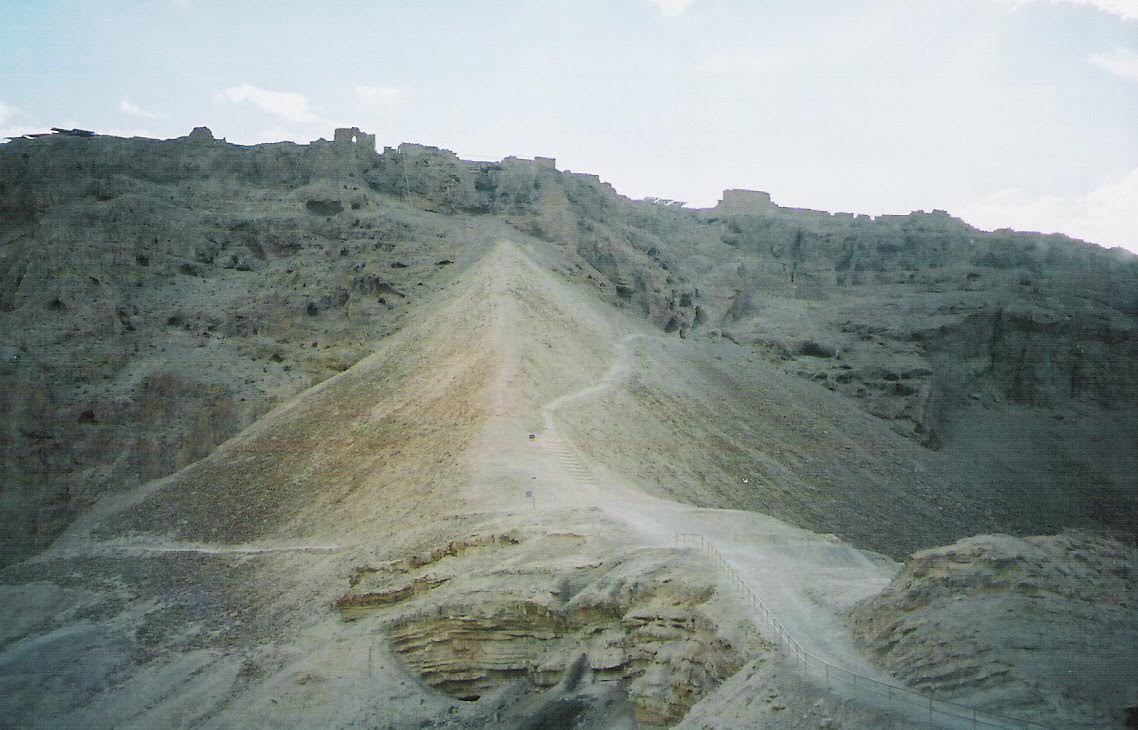Masada
6 Things to Look for in a Great Fortress
1) Location.
Herod the Great, in his paranoia, built the fortress of Masada between 37 and 31 BCE as a refuge for himself. He chose an isolated location at the western end of the Judean Desert, on a hard limestone mesa above the Dead Sea. A brilliant choice for one who is seeking privacy and security. The landscape surrounding Masada makes it extremely difficult to approach the mesa. According to the Roman historian Josephus, Herod’s fortress at Masada was strongly “entrenched against an enemy’s attack, both by nature and by the hand of man.”
(Today there are two ways to reach the top of Masada by foot. One is by hiking up the siege ramp built by the Romans during at siege of Masada in 73-74 AD located on the western side. The other is a winding snake path located on the eastern side. Both are very difficult hikes, but doable and the sense of accomplishment is exhilarating! Be sure to carry lots of water if you do choose to make the hike!)
2) Food and Water Supply.
Another must have in a fortress is a place for storing food and water. Why? One reason is that this particular fortress was located in a desert! Food and water were not easy to come by in such a place. Secondly, if an enemy did attack, a surplus of food and water would be necessary to sustain the inhabitants throughout the siege. In a brilliant engineering feat, Herod cut out large cisterns in the rocks to serve as reservoirs for collecting life-sustaining rain water. He also built large storehouses for storing grain, wine, oil, and dates.
3) Palaces.
Two palaces to be exact. Yes, Herod had two palaces built at Masada. The one which served as his residential palace was located on the northern edge of Masada overlooking the Dead Sea and provided total privacy and security. It consisted of three terraces connected by a staircase cut out of the rock. Herod’s ceremonial palace was located on the western side and served as the administration center of Masada.
4) Bath House and a Swimming Pool.
Being a mini Roman city located in the desert, a bath house and a swimming pool of course would be a necessity.
5) Armory and Barracks.
Just as food and water storage were essential, so too weapons and soldiers would be essential assets at the fortress in order to be prepared for an attack by the enemy.
According to Josephus in 73 BCE a group of Jewish zealots who were fighting for their independence from the hand of the Romans held out at Masada. The Romans arrived at Masada, built an encampment and a siege ramp (both still visible today) and after a long siege broke through the fortress and accessed the stronghold. According to the story, once the zealots realized that the Romans were soon to breach the walls of Masada, their leader decided that death by their own hands would be better than being captured by the Romans. So, they burned everything and killed each other until there was one left who then committed suicide.
6) An Escape Route.
One might ask the question, if they had all killed themselves, how did Josephus know what happened to the Jewish defenders at Masada? In his account Josephus reveals his source: “They [the Jewish defenders] had died in the belief that they had left not a soul of them alive to fall into Roman hands; but an old woman and another…escaped by concealing themselves in the subterranean aqueducts.”
http://www.jewishvirtuallibrary.org/jsource/Archaeology/Masada1.html
https://en.wikipedia.org/wiki/Masada
http://www.bibleplaces.com/masada/
Josephus, Flavius. The Jewish War.



